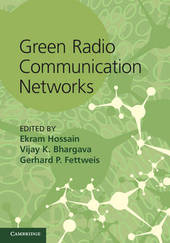
|
Green Radio Communication Networks
Hardback
Main Details
| Title |
Green Radio Communication Networks
|
| Authors and Contributors |
Edited by Ekram Hossain
|
|
Edited by Vijay K. Bhargava
|
|
Edited by Gerhard P. Fettweis
|
| Physical Properties |
| Format:Hardback | | Pages:440 | | Dimensions(mm): Height 249,Width 178 |
|
| ISBN/Barcode |
9781107017542
|
| Classifications | Dewey:621.384 |
|---|
| Audience | | Tertiary Education (US: College) | | Postgraduate, Research & Scholarly | | Professional & Vocational | |
|---|
| Illustrations |
22 Tables, black and white; 171 Line drawings, unspecified
|
|
Publishing Details |
| Publisher |
Cambridge University Press
|
| Imprint |
Cambridge University Press
|
| Publication Date |
5 July 2012 |
| Publication Country |
United Kingdom
|
Description
The importance of reducing energy costs, reducing CO2 emissions and protecting the environment are leading to an increased focus on green, energy-efficient approaches to the design of next-generation wireless networks. Presenting state-of-the-art research on green radio communications and networking technology by leaders in the field, this book is invaluable for researchers and professionals working in wireless communication. Summarizing existing and ongoing research, the book explores communication architectures and models, physical communications techniques, base station power-management techniques, wireless access techniques for green radio networks, and green radio test-bed, experimental results and standardization activities. Throughout, theoretical results are blended with practical insights and coverage of deployment issues. It serves as a one-stop reference for key concepts and design techniques for energy-efficient communications and networking and provides information essential for the design of future-generation cellular wireless systems.
Author Biography
Ekram Hossain is a Professor in the Department of Electrical and Computer Engineering at the University of Manitoba, Canada, where his current research interests lie in the design, analysis and optimization of wireless/mobile communications networks, smart grid communications, cognitive and green radio systems. He has received several awards including the University of Manitoba Merit Award in 2010 (for Research and Scholarly Activities) and the 2011 IEEE Communications Society Fred Ellersick Prize Paper Award. Vijay K. Bhargava is a Professor in the Department of Electrical and Computer Engineering at the University of British Columbia, Canada. He has served on the Board of Governors of the IEEE Information Theory Society and the IEEE Communications Society and was President of the IEEE Information Theory Society. He was recently appointed as the Director of Journals for the IEEE Communications Society. Gerhard P. Fettweis is the Vodafone Chair Professor at Technische Universitat Dresden, with 20 companies from around the world currently sponsoring his research on wireless transmission and chip design. An IEEE Fellow, he runs the world's largest cellular research test beds, coordinated the EASY-C project and has received numerous awards. He began his career at IBM Research and has since developed nine start-up companies.
Reviews'This book is an excellent summary of existing literature on green communications from a communications theorist point of view. It can be extremely valuable to researchers in this emerging area.' Vahid Tarokh, Harvard University '... an excellent snapshot of the state of green in wireless networking and ... a nice overview of who is doing what and where in the field.' Alfy Riddle, IEEE Microwave Magazine 'This is one of the first books related to the area of green wireless communication. It provides a good overview of different research works carried out independently by various groups.' Michal Wagrowski, IEEE Communications Magazine 'This book contains contributions from almost 60 scientists and engineers in academia and industry. Green Radio Communication Networks is an excellent snapshot of the state of green in wireless networking, and it is a nice overview of who is doing what and where in the field.' Microwave Magazine
|